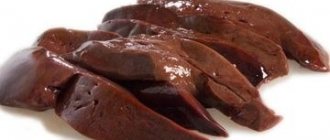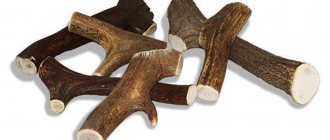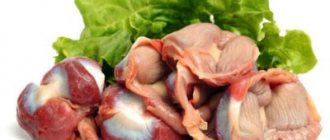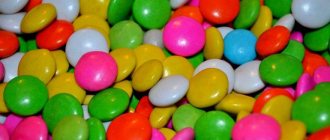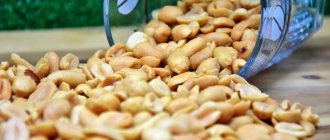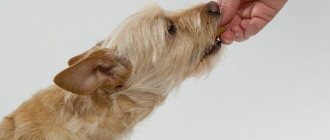Among animals, sweet tooths are as common as among people, but with excessive consumption of fast carbohydrates, animals develop quite human problems. Why dogs can’t eat sweets, what diseases candy, buns and chocolate can cause, what can replace them - every pet owner needs to know the answers to these questions.
Dangerous sweets for dogs
A dog is very different from a person. Her body is focused on processing meat, and her stomach has difficulty coping with plant foods. The pet is able to partially digest some things, while others cannot be digested at all. The first category includes sugar .
In the process of evolution, dogs did not need enzymes that break down glucose in large quantities. Under natural conditions, animals could only obtain sugar from fruits. “Delicacies” were rarely encountered, and they were eaten in relatively small quantities.
What happens in a dog's body when it receives another piece of candy or ice cream? The liver is responsible for breaking down carbohydrates. Some of the glucose is sent to the tissues to provide the body with energy here and now. The excess is converted to glycogen and remains in the liver as reserves. The reserve is later used to compensate for the shortfall.
The main problem is that in dogs the line between “necessary” and “unnecessary” is very close to zero. As a result, almost all glucose is stored. Add to this the serving sizes. A glass of ice cream is sometimes too much even for a person. For an animal whose weight can be 10 times less, this is a complete sugar shock.
The liver's capabilities are limited. She cannot put aside supplies indefinitely. At some point, there are too many metabolic byproducts. They disperse throughout the body and cause allergic reactions . Moreover, the substances are removed for a very long time. Your pet may continue to have symptoms for another month. Often, owners have already managed to forget that they gave the treat and treat the animals for fungus, chicken allergies or flea bites.
Is sugar harmful or beneficial to the body?
Can dogs eat cherries, raspberries, apricots and other berries?
Many people misunderstand what sugar actually is. Therefore, they try to exclude it completely from their pet’s diet. But this cannot be done completely. After all, what is sugar? This is carbon (sucrose), which consists of glucose and fructose. Both components are important for maintaining energy balance in the body, as well as cell renewal.
Note! Sugar is found in cereals (there is a lot of it in rice and oatmeal), fruits and vegetables, and, of course, in sweets. Therefore, in order to create a complete menu for your dog and fill in the gaps in the amount of carbohydrates, it is better to replace the sugar from sweets with the sugar found in cereals and fruits. Then this is an absolutely balanced diet.
But pure sugar, which is mostly found in sweets, is harmful to dogs. First of all, there is nothing useful in such products except the carbohydrates themselves. Secondly, carbohydrates are stored in large quantities as fats. Also, an increased amount of glucose in saliva is deposited on the enamel of a dog’s teeth, which is 4 times thinner than a human’s. Glucose is an excellent food and breeding ground for bacteria, so excess sugar in the blood causes tooth decay and gum inflammation.
For your information! With excessive amounts of sugar in the diet and the pet, diabetes occurs, and this cannot be treated, it can only be stopped, so caring for such a dog will be incredibly difficult. Sweeteners are also not suitable for a dog’s body.
Symptoms of a dog overeating sweets
What happens if you feed your dog something sweet? Let's move on to more obvious manifestations of the disease.
Sweets usually contain a lot of fat. The delicate canine liver copes with it worse than the human liver. As a result, the pet begins to develop diarrhea . With prolonged feeding, the “filter” may not be able to withstand it. The pancreas will also be affected. Pancreatitis may develop .
If there is too much sugar, after diarrhea your pet will begin to experience symptoms that usually indicate an allergy. Red spots will appear and the pet will scratch itself. After desserts, more wax forms . The eyes are streaming . In advanced cases, the coat becomes dull and oily , and the skin flakes off. The discharge causes a pungent odor .
What to do if your pet becomes ill? In most cases, it is enough to simply exclude sweets from the menu. After some time the animal will feel better. If complications arise, they need to be treated separately.
What is strictly forbidden to feed
The most important enemy of a dog's health among sweets is chocolate, followed by all other products. Some types of fruit are also contraindicated. These are grapes, as well as oranges and other citrus fruits, as they cause allergies. Confectionery products are prohibited, as yeast causes bloating and poor digestion, as well as fermentation of carbons in the colon.
Lethal dose of chocolate for different dogs
What sweets and candies are good to give to your dog?
It's not all so sad. Dogs can sometimes be pampered with sweets if done wisely. What desserts are safe for tailed friends?
Fruits
Permitted foods include, for example, apples and unripe bananas. This does not mean that the pet needs to be fed or forced. If your pet wants it, give it a couple of slices. Fruits contain sucrose, the “correct” analogue of glucose. In addition, the treats contain minerals and vitamins.
Berries
Give in small quantities and very carefully to avoid allergies. Many dogs love to eat raspberries. It is acceptable to occasionally pamper your pet with blueberries or blackberries. It is better to avoid grapes and raisins, as they are toxic to the kidneys. A couple of berries will not cause immediate severe poisoning, but will force the body to work to the limit. Regular use will lead to dire consequences.
Nuts
Eligible foods include pine nuts, almonds, cashews and peanuts. The latter is classified as a bean, but we decided to include it here. Salted pistachios, nutmeg and macadamia are dangerous. It is highly recommended to avoid walnuts and hazelnuts. Buy treats only from reputable sources, as there may be mold inside that cannot be seen with the naked eye.
Vegetables
They contain relatively little sugar, but this is enough for a dog. You can offer your pet pumpkin or carrots. A mixture of the latter with an apple will serve as a kind of toothpaste. The tough pulp perfectly removes plaque.
Meat biscuits
Of course, we are not talking about a “human” dessert, but about a special meat analogue. To knead the dough, buckwheat, rye, oat or wheat flour, chicken eggs and minced meat (beef, chicken or fish) are used. It is permissible to add a little honey. Gourmets can offer liver cookies or with oatmeal.
How to replace harmful things
You can also add a small amount (1 teaspoon) of natural peanut butter to your food, but you should pay attention to the composition. The main thing is that there are no other additives, and the sweetener should be honey.
It was already mentioned above that it is best to choose dried and fresh fruits for this, but do not forget about the dog’s balanced menu. If your dog suddenly starts asking for sweets, then you need to think about whether everything is okay with his diet. Before going to the vet, you can try changing the menu.
First of all, a lack of carbohydrates can occur when the bulk of the diet consists of meat and milk, because the body also needs other substances and microelements. Therefore, in order to improve nutrition and the condition of the body, it is worth adding buckwheat, rice, and wheat cereals to the diet. They must be boiled either in water or in meat broth, but cannot be stewed or fried, or seasonings must be added. It would also be a good idea to supplement your diet with cottage cheese or sour cream.
Important! When the menu consists of the required amount of protein (meat), fat (dairy products) and carbohydrates (porridge), then the likelihood that the dog will ask for sweets is low. In this case, the owner should not even replace the sweets, because there is no need for them.
Your pet needs special treats during training.
The importance of a healthy diet
Can dogs have natural sugar?
Chocolate and sugar-containing products can be replaced with natural ingredients that your dog will definitely appreciate. Experts recommend the following treats:
- fruits: unripe bananas, apples;
- nuts: peanuts, almonds, cashews, pine;
- berries: blackberries, raspberries, blueberries;
- vegetables: pumpkin, carrots.
When feeding, it is important to pay attention to the reaction: if you don’t like the fruit, do not force feed it. Observe the body's reactions, whether allergies or stomach upsets occur. Fruits contain a lot of sucrose, necessary for health and development, minerals, and vitamins.
Photo source pixabay.com
Important: A dog’s gastrointestinal tract can only digest natural ingredients; avoid fillers and artificial flavor substitutes.
It is forbidden to feed the animal raisins and grapes: this is poison in its pure form, leading to kidney damage.
Dried fruits are offered in moderation - they have a high concentration of sucrose.
It is not recommended to give avocados: persin, contained in high concentrations, can cause serious stomach upset, pain and cramps. Potatoes in any quantity provoke attacks of diarrhea - in both dogs and cats.
Honey is a healthy natural treat. It is recommended to mix it with your regular diet, adding flavor and a pleasant aroma to food.
Groundbaiting with sesame seeds, sunflower seeds, peanuts, and almonds is common. You should be careful with nuts: they contribute to excess weight gain.
Experts have different opinions about beets: they have a slight laxative effect, but the microelements they contain are beneficial for the immune system. It is necessary to monitor the reaction of the dog’s stomach, because it has a laxative property.
How to properly give treats to your dog
If you just want to keep your pet busy with a treat, then there are no specific recommendations on how to offer this treat. But if you are engaged in training and education, here are some points that must be taken into account:
- The animal should receive treats only as a reward. You should not give this delicious food as a regular meal or for no reason. This only enhances the effect: anticipation, joy, trying to follow the command and get the most delicious treat in the world.
- Offer rewards directly during the execution of the command, but not later. For example, you commanded “Sit” and the pet sat down. If, after executing a command, you offer a treat and he jumps up for it, the command is devalued. A delicacy is no longer regarded as encouragement, but as begging.
- If you still have a small puppy who is just making his first progress, be it the “Fu” command or a successful “visit to the street toilet,” be sure to reward your pet with a treat for each such achievement, for each correctly executed command. In the future, when the four-legged dog learns to do everything correctly, it is not necessary to reward it with a treat every time. You can use other methods of encouragement: praise, stroking, play.
Pregnant, nursing and puppies
A puppy's appetite may increase significantly, and therefore, if she does not have enough calories from her diet, she will try to get them herself. For example, stealing a couple of delicacies from the table. Cookies, chocolate and candy are not good for a pregnant dog. The jumping level of glycogen will affect not only her condition, but also the puppies.
Reference! For a puppy, an overdose of sugar is doubly destructive - his body is simply not able to digest such an amount of glucose. Even one candy can provoke a severe allergic reaction.
Strictly prohibited
There are sweets that are especially harmful to dogs - for example, ice cream. It is a combination of milk, fats and sugar. This is a huge burden for a pet’s body, especially a small breed. At best, the animal will suffer from indigestion, diarrhea and the difficulties described above.
Flour confectionery products - white flour and sugar are a very harmful combination not only for dogs, but also for people. Their use should not be limited, but completely excluded from the animal’s diet. Grapes and raisins are record holders for sugar content. It is strongly not recommended to give them to your dog.
It is strictly forbidden to give your dog chocolate. This seemingly simple treat can become deadly for your pet. You can read more about this in the article “Can a dog have chocolate?”
Special cubes
During training, you cannot do without a food “reward”, otherwise the process will be long. But sweets are not the best option to reward and pamper your dog. For them, their own special goodies have long been created that do not harm the body, but, on the contrary, improve its condition. There are special cubes and cookies that contain chicken, carrots and spinach. They are suitable for training, as they are not high in calories, but at the same time they contain many microelements.
It is better to replace sweets with special cookies
Medicines containing antiallergic agents and vitamins are also sold in the form of sugar cubes and are used to treat eczema and dermatitis. This is perhaps the only case when you can give a dog sweets so that the dog wants to eat the medicine. But this is contraindicated for dogs with diabetes and pancreatitis, it is prescribed only by an experienced veterinarian; such a remedy cannot even be considered as a treat.
Thus, sweets and chocolates are prohibited for the dog. If you want your dog to live a long, happy, and most importantly, healthy life, it is better to switch to special sweets for dogs, which are sold in veterinary pharmacies.
Consequences
Uncontrolled consumption by a dog of sweets familiar to humans can lead to diseases of the oral cavity, endocrine, cardiovascular and musculoskeletal systems.
Due to severe complications, the pet's life expectancy is reduced. To avoid these consequences, all confectionery products are removed from the diet . Unsweetened vegetables and fruits, unroasted seeds and nuts, as well as industrially produced dog delicacies are offered as treats in limited quantities.
In case of overeating or poisoning from sweet food, manifested by nausea, vomiting, and loss of coordination, the dog is immediately taken to a veterinary clinic.
Read more: What to feed a pug puppy
Treats for training
Pieces of treats should be small in size, since this is still not food, but a reward. In addition, during training, the dog should quickly swallow the treat and not fiddle with it.
The treat should be moderately dried so as not to get your hands and clothes too dirty.
If we take the total daily diet as a percentage, then the amount of treats should not exceed 5-10% of the total diet. Why? Yes, here’s why: so that when training a dog, he will happily work for a tasty treat, it is advisable to make it from meat, liver or any other natural product. And this is quite filling and high in calories.
Pieces of dried or oven-dried meat or offal are ideal for training. As a rule, for Jackusik I cook pieces of liver, lung or turkey. I will tell you how to do this further.
Prohibited Products
You can’t think that all sweet fruits are suitable for satisfying a dog’s carbohydrate hunger.
The list of prohibited products includes:
- fresh/dried grapes - they catalyze the fermentation process in the intestines and are considered quite toxic;
- persimmon, cherries and cherries - consumption of these fruits threatens intestinal obstruction, which occurs due to the fault of the seeds, which provoke inflammation of the small intestine;
- citrus fruits - the substances they contain often become a powerful food irritant. Four-legged dogs usually don’t like the taste of citrus fruits, but if an orange slice is eaten, monitor the reaction of the dog’s body;
- avocado – it contains persin, a fungicidal toxin to which domestic animals (rabbits, horses and birds) react especially acutely. For dogs, persin is not as dangerous as it is unpleasant, as it can lead to diarrhea;
- sweet acorn - this forest delicacy ends up not only in the stomachs of wild boars. Sometimes it is swallowed by ill-mannered dogs whose owners have not taught selective eating behavior on the street/in the park. A dog that has eaten acorns receives a considerable dose of tannins, which threatens not so much poisoning as constipation.
Important! If you want to pamper your dog with sweets, take into account the advice of a veterinarian who has been caring for the animal from the first days of life and knows the weak points in its body. If the doctor gives the go-ahead for nuts and fruits/vegetables, follow the measure and monitor your pet’s condition.
There is a second list of prohibited sweets, which includes confectionery, baked goods and any (for example, fermented milk) products with dyes, flavors, preservatives and sweeteners.
The following sweets are especially undesirable:
- chocolate – it contains theobromine, which is harmless to humans, but extremely dangerous for animals whose body is not adapted to excrete this alkaloid. In large quantities, it turns into poison, having a negative effect on the dog’s heart muscle and central nervous system. A bar of high-quality chocolate can even be fatal;
- Xylitol is a polyhydric alcohol sweetener. Manufacturers love to add it to their sweet products. It is most often found in chewing gum, which dogs often find on the pavement;
- yeast dough - it also contains refined sugar and single-celled fungi (yeast itself). When it gets into a dog's stomach, the dough swells, causing pain, pain and flatulence. It is also believed that yeast has a toxic effect on the dog's body.
You will have to study the gastronomic preferences of your four-legged friend throughout his life . If he wants something sweet, experiment based on your knowledge of the benefits/harms of specific foods, but start with small portions. Once healthy treats have been identified by you and approved by your dog, stock up on them for future use. They can be useful to mask the unpleasant taste of the medicine if the dog gets sick or when training it.
Return to content
Why not
Carbohydrates obtained from food are needed as a source of energy. To maintain healthy metabolic processes, your pet needs complex carbohydrates. They are found in grains, vegetables and unsweetened fruits. Treats such as cookies, lollipops, buns and cakes are rich in simple carbohydrates, the consumption of which leads to a rapid increase in blood glucose levels.
To understand whether puppies and dogs can have sweets, you need to know the characteristics of the animal’s gastrointestinal tract.
A dog is a predator whose body is adapted to digest natural food of animal origin: meat, offal, dairy products. But the body does not produce enzymes to absorb glucose, so it has a destructive effect on various organ systems.
How sweets affect a dog's body
Regular consumption of sweet treats provokes dangerous complications:
- Caries, gum disease, tartar: sugar, when mixed with saliva and food debris, becomes a favorable breeding ground for pathogenic bacteria. A dog's tooth enamel is 5 times thinner than a human's. Therefore, even infrequent consumption of sweets leads to the development of periodontal disease and caries. Diseases of the teeth and gums not only provoke bad breath, but also lead to disruption of the gastrointestinal tract.
- Indigestion: Eating high-fat, high-sugar foods for your dog puts a lot of stress on the liver and pancreas. This is manifested by nausea, vomiting, and stool disturbances.
- Psychological dependence: a single consumption of sweets in minute quantities contributes to addiction. Sensing the smell of treats, the pet will always beg, violating discipline. It is much more difficult to wean a dog from this behavior than to prevent it from becoming addicted to sweets.
- Obesity: Regular consumption of food with high energy value provokes obesity. Representatives of small breeds and older dogs are prone to gaining excess weight. Obesity increases the risk of developing diseases of the joints, heart and endocrine system. Because of this, the pet's life expectancy is reduced.
- Allergies: sweets, cookies, buns and cakes are strong allergens. Even a single consumption of sweets provokes symptoms typical of an allergic reaction: skin rash, itching, redness of the eyes, restless behavior.
The more often foods with sugar are consumed, the faster complications develop.


